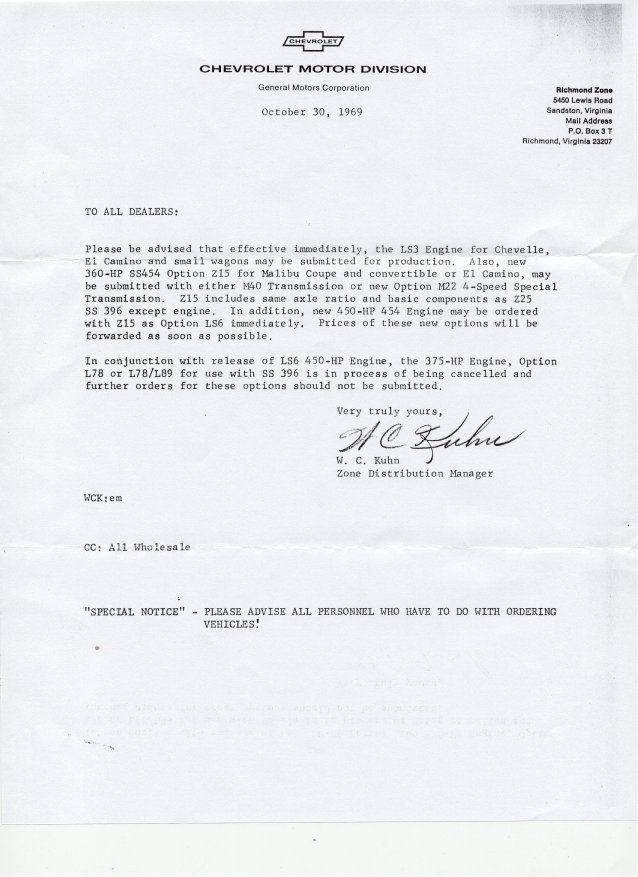LS3 vs. L34/L78 vs. LF6
Lots of interest, discussion, and confusion about the "396/400/402" engines in 1970.
Beginning in late 1969 all 396 cid Mark IV (big block) engines were increased to 402 cid with a .030 overbore. The first question that comes to everyone's mind (at least my mind) is why take a perfectly good engine that had been in service since January 1965 and increase the bore by a mere .030 to gain 6 cubic inches? And, no it wasn't because the Tonawanda engine plant had 'leftover' 396 engines or found a bunch of them rusting away outside and decided to bore them .030 to clean them up.
The most logical reason for the increase in cubic inches was slightly more lax emission standards on engines 400 cubic inches or more. In late 1969 the Tonawanda engine plant began producing the 402 cid engine. Due to some issues with the 1970 Camaro, the 1969 Camaro continued into production longer than expected and some of these 402 cid engines made their way into late 1969 Camaros that were ordered with the 396 cid engine. These can be identified by the 3-letter engine identification suffix codes in place of the normal 2-letter codes. Beginning in 1970 all Chevrolet engines began using a 3-letter engine identification suffix code.
The Chevrolet L35 396/325hp engine was dropped for the 1970 model year and the L34 396/350hp engine became the base (or standard) engine when the RPO Z25 SS-Equipment option was ordered on Chevelles. Until its demise early in the model year the RPO L78 396/375hp engine was still available as an optional engine. For 1970 both of these engines actually displaced 402 cubic inches, not 396 cubic inches. The SS396 nameplate was retained because Chevrolet already had four years invested in the "SS396" brand and knowing that the SS396 option was going away in 1971 chose not to call the 1970 option an SS402.
To muddy the waters a bit more, in 1970 the RPO LS3 engine was introduced. This was basically the same engine as the L34 350hp engine but with a milder camshaft and rated at 330hp. This LS3 engine also displaced 402 cubic inches but was labeled as a 400-4 (the -4 meaning a 4-barrel carburetor) or as a 400 Turbo-Jet to distinguish it from the L34/L78 family. This LS3 engine was available in ANY 1970 Chevelle, regardless of series, except when RPO Z25 or RPO Z15, the SS 396 and SS454 Equipment option was ordered on a Malibu sport coupe, convertible, or sedan pickup.
Really stirring the pot, Chevrolet introduced a 400 cubic inch small block V8 in 1970. This engine was available in the full size Chevrolet as well as the 1970 Monte Carlo under RPO LF6. Since this engine only came with a 2-barrel carburetor it was often shown in mechanics tune up manuals as a 400-2 or Turbo-Fire 400.
Recap for 1970:
SS396 Chevelle engines were really 402 cubic inches for both the L34
and L78 but marketed as 396s
Non-SS Chevelle LS3 engines were really 402 cubic inches but
marketed as a "400-4" or Turbo-Jet 400
Full size Chevrolets and 1970 Monte Carlos could order the 400 cubic
inch small block marketed as a "400-2" or Turbo-Fire 400
but no LF6 engines were sold in other Chevelles.
By the 1971 model year the "396" engine name was no longer used by Chevrolet. The 402 cubic inch LS3 now became the base "big block" engine and could be ordered in any Chevelle series and body style whether SS optioned or not.


 Home
Home Decode
Decode Tech
Tech Tools
Tools Dale's Coins/CDs
Dale's Coins/CDs Contact
Contact Chevelle
of the Month
Chevelle
of the Month Things
For Sale
Things
For Sale Custom
Stickers
Custom
Stickers